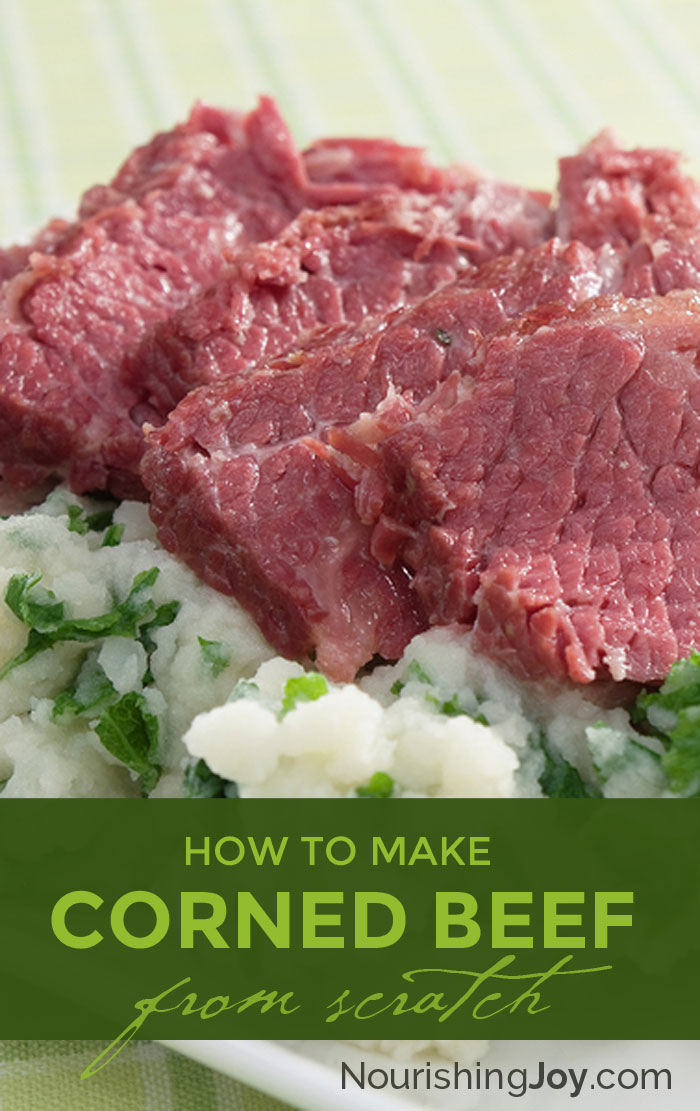Homemade Traditional Corned Beef
This post may contain affiliate links, including those from Amazon.com, which means we earn a small commission off your purchases. And here's the thing: We only mention services and products that we think are truly worth your attention, whether they're free, paid, or otherwise. This site relies on YOUR trust, so if we don't stand behind a product 110%, it's not mentioned. Period.
Want more St. Patrick's Day inspiration? Check out these yummy recipes!
Matcha Shortbread (Green Tea Shortbread)
The Perfect Reuben Sandwich
Sourdough Reuben Picnic Buns (the classic sandwich in a handy no-mess bun!)
Corned Beef Tongue with Horseradish Cream Sauce
It's the beginning of March and St. Patrick's Day is just around the corner. Since I'm not Irish-American, I don't feed great pressure to commemorate the holiday, but I certainly consider the Reuben sandwiches and good beer that celebrate the day to be welcome noshing traditions in this cold and rainy season.
Corned beef is one of my favorite meats and it's not difficult to make at home, which is attested to by cooks across the web. Just type in “homemade corned beef” to your favorite search engine and you'll come up with pages galore.
(By the way, “corning” is a technique for preserving or curing meat by soaking it in brine for long periods of time.)
When beef is preserved using traditional methods, it's a fermented food that nourishes your body, in addition to being melt-in-your-mouth satisfying. It takes 5-10 days to cure, so now is a good time to get started in order to have your meat ready for March 17.
Every time I make this, my husband and I look at each other starry-eyed and say, “Why don't we make this more often?!?!”
Yes, it's that good.
Traditional Corned Beef
Ingredients:
1 3-pound beef brisket, grass-fed (see note)
1 cup unrefined coarse sea salt
1/4 cup unrefined cane sugar (optional, no substitutes)
Pickling spice (recipe follows)
5 cloves of garlic, minced
2 cups whey or sauerkraut brine*
2 cups celery juice**
*Get sufficient whey by straining 2-3 quarts of yogurt in cheesecloth for an hour or so – plus you end up with thick Greek-style yogurt. Yum!
**obtain celery juice by running celery stalks through a juicer or click here to see where to buy celery juice – I recommend juicing if possible, as the fresher the better for this project)
Pickling Spices:
3 bay leaves
1 stick cinnamon, broken into pieces
2 tablespoon mustard seeds
2 tablespoon whole coriander seed
2 tablespoons whole black peppercorns
1 tablespoon whole cardamom pods (optional)
1 tablespoon juniper berries
4 cloves
Method:
Rinse the brisket and pat it dry. If you have time, freeze it in a deep freeze for 14 days, then thaw it completely in the refrigerator. Otherwise, continue with the recipe as usual, but add in a cooking time at the end.
When the meat is completely thawed, mix the salt, sugar, pickling spices, and garlic together in a small bowl, breaking up the bigger items with the back of a spoon (or use a mortar and pestle to make it easy). Rub as much of the mixture into the meat as possible, massaging it in if needed.
Place the brisket in a glass container or jar with a tight-fitting lid. Pour the whey and the celery juice over the brisket, along with any of the salt mixture that fell aside. If the brine does not cover the brisket entirely, add enough filtered water to cover it. Weigh it down if necessary with a plate or a jar filled with water.
Place the lid on the container and put the brisket in the refrigerator. Let it cure for 5-10 days (count on at least two days per pound), turning once each day and ensuring that the meat is covered in brine at all times. Add filtered water if necessary.
Once the meat is cured, toss the brine and rinse the meat to reduce the saltiness. If you originally froze the meat, it's now ready to eat raw in whatever way you best like your corned beef: Reuben sandwiches, crock pot corned beef and cabbage, New English Boiled Dinner, corned beef hash, corned beef and potatoes.
Keep in mind that unless you cook it at this point, it is still raw, which is recommended by Sally Fallon in her book Nourishing Traditions, but you need to have handled your meat properly to consume it in that state. See our notes below.
If you didn't freeze the meat or aren't comfortable consuming raw meat, use one of the following methods to cook your corned beef.
Corned Beef in the Slow Cooker
Place your cured, rinsed corned beef in a slow cooker on top of one head of cabbage cut into 8 wedges (this will help the corned beef cook evenly and with the proper moisture). Pour 1 1/2 cups of water over and cook on low for 8-10 hours or on high for 5-6 hours until very tender and the meat shreds easily with a fork.
Corned Beef on the Stovetop
Bring a stockpot of water to a boil, then submerge the meat and simmer it very gently over low or medium-low heat until it's fork tender – generally about 2 1/2 – 3 hours.
Why Grass-Fed Is Important
Choosing grass-fed beef if at all possible is especially important in this recipe.
By eating the meat in a somewhat raw state, the enzyme structures are kept intact, as with most raw foods, which makes the meat more digestible and keeps more nutrients bio-available, thus you absolutely need as safe a product as possible. Grass-fed animals can still host bacteria infestations, such as e-coli, but the incidences are greatly reduced in animals that haven't been in close confinement.
Grass-fed meat is also significantly higher in CLA (conjugated linoleic acid), a potent cancer-fighting fatty acid that only exists in meat that comes from pastured animals (with one exception), and this benefit exists whether you cook the corned beef or eat it raw.
A Few Notes
This recipe calls for freezing the meat first. As long as your meat is fresh when you place it in the freezer, by freezing it for at least 14 days, any bacteria present in the meat will be unable to survive. If you don't have time to freeze the meat or you choose not to, you'll need to cook the meat after curing it.
And what's the deal with celery juice, you might ask? Celery juice is the most potent source of natural nitrites, the preservative that kills bacteria and helps the meat retain its flavor. Artificial nitrites such as saltpeter or even those found in pink salt, which are often used in corning beef, give the beef a deep red color, which celery juice won't do, so don't be alarmed. To read more about natural curing methods, both Niman Ranch and Red Cat Restaurants have some very helpful information.
And what is curing anyway and why is it safe to eat raw meat that has been cured? I find this description enlightening:
“Curing, no matter which method, involves several processes, the most significant of which is denaturing of the proteins. This happens when salt is introduced to the meats proteins. Proteins are coils and the salt causes the proteins in the muscle fibers to unwind and [the salt then can] absorb the extra water trapped inside. Water inside your meat spells trouble because bacteria love water so eliminating it by salting and drying allows for longer storage.” – Red Cat Restaurants






I absolutely love corned beef. And cabbage. One of my favorite meals, hands down. I don’t think I can pull this off for St. Patrick’s Day this year but I just might make it a March goal. That is doable. Thanks so much for sharing. The pics have me drooling!
Is that 1-3 or 13 lbs of brisket?
Oh, my goodness! A 13 pound brisket would need a 5 gallon bucket to brine! 🙂
That’s definitely ONE three-pound brisket. I am seeing that since I changed the typography on the site, those two numbers have gotten squished rather close together, so I’m sorry about the confusion.
Where do you buy your celery juice?
Hi, Amanda.
I don’t know of anywhere to buy celery juice – I just juice it myself by running celery stalks through a juicer. If you don’t have a juicer, perhaps go to a juice bar in your area (if you’re somewhere urban) and request it there.
I’ll pose the question to everyone else – Does anyone else have any other ways to procure celery juice?
I’ll also ask tomorrow on our Facebook page and in our G+ community – you can check those threads to see if anyone else has any ideas.
Facebook: https://www.facebook.com/nourishingjoy/posts/854512507898704
G+: http://bit.ly/1eoYd1E
Updated to add: A person on one of the Facebook threads pointed out it can be purchased at Amazon: http://amzn.to/1hSRRCB (affiliate)
The Salus brand that’s linked to is a common brand for a number of whole food vitamin and supplements, so you might look for this celery juice at your local health food store as well, if they carry other Salus products.
If my local health food store sells the beef already frozen, is that still acceptable to keeping it raw after fermenting? They do have grass fed, but I’m not sure how quickly it’s frozen after killing the cow. I really want to try this raw, but would love to know if you would use it frozen from the store, thanks! 🙂
Laci,
Can you perhaps ask the store manager? Or call the farmer or butcher who processes the beef? You can certainly make this recipe with previously-frozen beef (in fact, if it’s been in a deep freeze for more than 14 days, that’s actually PREFERABLE to never-been-frozen beef), but I agree – if you’re going to be eating it raw, you would want to know if it sat out at any point. I would think that they would handle the meat with utmost care since it’s headed for public consumption, but knowledge is power in this case. 🙂
And if not, it’s delicious cooked too, although I totally understand that it’s not the same. Either way, enjoy!
Do you think I could use a venison roast in lieu of a beef roast? Venison is so much leaner that I wasn’t sure if it would work.
Venison should work. In this recipe, the fat doesn’t play as significant a role as it does in things like braised meats and slow cooker pulled pork. I’ve never tried corning venison (even though I love venison!) so I’m not sure about the flavor. Let us know how it turns out! 🙂
Will do. Thanks very much!
Results from Corned Venison … I corned 2 small venison roasts. One I tried raw and it was wonderfully flavorful and really tender! Since I’m on a ketogenic eating program, I ground most of it with coconut oil into a raw corned venison pate. YUM!
The other roast I cooked in the crockpot per your recipe with added root vegetables and my husband loved it! It had a different texture than traditional corned beef. Not as flaky, but moist, flavorful & tender. Thanks for the great recipes!
Wow – thank you SO much for giving us such great details on how each version turned out. That’s really wonderful.
And they both sound so GOOD! Now I’m wishing we had some venison in the freezer. 🙂
Thanks again.
Great post. I’m wanting to make the corned beef for reubens and corn beef hash. Should I cook after the fermentation for this? I like the idea of eating it raw, but I’m unsure of the flavors.
Thanks!
Great question! Typically it’s cooked for Reubens and corned beef hash (which would cook it anyway!), so I’d recommend it for both flavor and texture for both of those dishes. 🙂
I hope that helps!
Great, thanks!
Could I blend celery in my high powered blender and use that mixture instead of the juice? It seems like that would have the same compounds?
Yes, absolutely, although you’ll want to add a few tablespoons of water while you’re blending so that you end up with pulp rather than just chopped celery (and so it doesn’t cause a cavitation) and then strain it through cheesecloth so that you’ve only got the juice. (Just let the pulp hang for 30-60 minutes.)
This will make sure there’s a high enough ratio of celery juice in the brine as well as remove the pulp. You want all that juicy goodness to be able to work its way into the fibres of the meat, which the pulp can’t do. 🙂
I hope that helps!